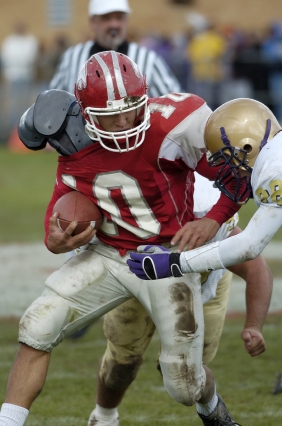When the 1996 Olympics were being held in Atlanta, I remember Muhammad Ali lighting the torch at the opening ceremonies, and how he shook from the Parkinson disease that devastated his body.
Since the 1920s, repetitive head trauma has been recognized as a cause of loss of neurological function in boxers, a condition originally called “dementia pugilistica”.
I confess; I am a fan of the gladiator sport that is American football. I enjoy cheering for “my” Green Bay Packers, and I have even been to a game at historic Lambeau field. But I was astounded (and disappointed) when the big concussion brouhaha started in the NFL a couple of years ago, and the NFL seemed surprised that head injuries were linked to long-term neurological issues (1).
The concussion discussion continues in the NFL this year with the recent decision by the NFL to enforce, more strictly, the existing rules against illegal hits that are “devastating blows” or “head shots” because of a bad weekend when multiple players were sidelined with injuries resulting from helmet-to-helmet or “devastating” hits (2).
It’s an important discussion, not because it affects the NFL and how the game of football is played, but because it gets attention and resources placed toward understanding repeat head injuries and their long-term consequences.
A recent study published in the Journal of Neuropathology and Experimental Neurology (3), takes a first step to understanding the long-term consequences of repetitive head injuries.
In this study, Ann Mckee and colleagues looked at brain and spinal cord tissue from 12 athletes who were pathologically confirmed to have chronic traumatic encephalopathy (CTE). They obtained a history of injury and concussion and medical histories with as complete as possible description of neurological performance and motor symptoms at the time of death. Of the twelve patients, three had symptoms of motor neuron disease (MND). Motor neuron disease is a continuum of diseases characterized by loss of motor neuron control and includes amyotrophic lateral sclerosis (ALS).
ALS is observed at higher frequencies in athletes in contact sports. The protein, TDP-43, is a marker for ALS. In this study, the researchers stained the tissues from the 12 athletes to look for TDP-43 reactivity. In 10 of the 12 cases, the researchers found TDP-43 positive cells; in the tissues of the three athletes that also suffered from motor neuron disease, TDP-43 positive staining was found in both the brain and spinal cord.
These results suggest that the abnormal deposition of TDP-43 protein is associated with CTE, and that in some cases, it can extend beyond the brain into the spinal cord. When that happens, the affected individual begins to exhibit signs and symptoms of motor neuron disease.
Finding out that there is a continuum of pathology at the cellular level is one step to understanding better the consequences of repeated brain injury. Researchers are working to learn what the normal function of TDP-43 is in the cell and how it might be causing neurons to die or malfunction in these cases. But, there are a lot of unanswered questions about TDP-43, and it is probably only one very small piece of a complex molecular puzzle.
Very few people will ever play professional American football. But many people watch it.
And, many kids play contact sports in high school and college, and there are swimmers, divers, gymnasts, soccer players, skateboarders, skiers, hockey players and other athletes all who risk head injuries every time they take up the sport that they love. Head injuries are common in military personnel. Bicyclists and automobile drivers get bumps on the heads. Oh, and we can’t forget children jumping on beds or the college students who manage to sustain concussions playing ultimate Frisbee. A huge number of people would benefit from increased awareness of how to prevent, diagnose and best treat head trauma.
So maybe the NFL will use this opportunity not only to do something for their players, but to change the game of head injury for others as well.
References
- Mortensen, C. (2010) NFL to Announce Suspension for Hits. ESPN NFL. October 19.
- Schwarz, Alan. (2010) Concussion Committee Breaks with Predecessor. New York Times. June 10.
- McKee AC, Gavett BE, Stern RA, Nowinski CJ, Cantu RC, Kowall NW, Perl DP, Hedley-Whyte ET, Price B, Sullivan C, Morin P, Lee HS, Kubilus CA, Daneshvar DH, Wulff M, & Budson AE (2010). TDP-43 proteinopathy and motor neuron disease in chronic traumatic encephalopathy. Journal of neuropathology and experimental neurology, 69 (9), 918-29 PMID: 20720505
Michele Arduengo
Latest posts by Michele Arduengo (see all)
- An Unexpected Role for RNA Methylation in Mitosis Leads to New Understanding of Neurodevelopmental Disorders - March 27, 2025
- Unlocking the Secrets of ADP-Ribosylation with Arg-C Ultra Protease, a Key Enzyme for Studying Ester-Linked Protein Modifications - November 13, 2024
- Exploring the Respiratory Virus Landscape: Pre-Pandemic Data and Pandemic Preparedness - October 29, 2024


I support this article!